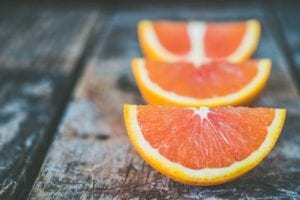Written by Joyce Smith, BS. This study explores the specific mechanisms by which grapefruit seed extract (GSE) inhibits the biofilm activity of food poisoning pathogens.
 The World Health Organization reports that food poisoning accounts for 420,000 deaths per year 1. Among the responsible pathogens, according to the Center for Disease Control and Prevention (CDC,) are Escherichia coli, Listeria spp., Salmonella spp., Campylobacter spp., and Staphylococcus aureus 2 which cause diarrhea, nausea, vomiting, fever, stomach ache, and cramps. The resilience of these pathogens is attributed to a protective biofilm which they can prod
The World Health Organization reports that food poisoning accounts for 420,000 deaths per year 1. Among the responsible pathogens, according to the Center for Disease Control and Prevention (CDC,) are Escherichia coli, Listeria spp., Salmonella spp., Campylobacter spp., and Staphylococcus aureus 2 which cause diarrhea, nausea, vomiting, fever, stomach ache, and cramps. The resilience of these pathogens is attributed to a protective biofilm which they can prod
uce on a variety of surfaces and which often renders them impenetrable to antibiotics and other compounds 3. It is well documented that the protective advantage of biofilms has contributed to the increased antibiotic resistance evident today, particularly for food poisoning pathogens such as S. aureus and E. coli 4. When bacteria cling to surfaces they produce a biofilm consisting of a polymer matrix of exopolysaccharides (EPS). Plant extracts, derived from the leaves, root, and seeds of plants, such as essential peppermint oil, are now available as natural antimicrobial agents that exhibit anti-biofilm activity against bacterial food pathogens 3,5.
In a current study, Song and colleagues 6 explored the potential anti-biofilm ability of grapefruit seed extract (GSE), on two food poisoning pathogens (S. aureus and E. coli) and its potential use for the food industry as a biofilm removal agent. GSE is a well-known, safe, and protective preservative that has already been shown in studies to be an effective antimicrobial agent against both gram-positive and gram-negative bacteria, and yeast 7.
Four bacterial strains, S. aureus7, S. aureus8, E. coli ATCC 25922, and E. coli O157:H4 FRIK 125 were cultured and their biofilms tested against varying concentrations of GSE. Cell surface hydrophobicity (the ability of cells to repel water), auto-aggregation, and mobility 8 (all important for bacterial colonization, adhesion, and biofilm growth) were determined.
The research team found that the rates of biofilm formation of S. aureus and E. coli were significantly inhibited by 64.8% and 63.1% for S. aureus7 and S. aureus8 respectively, and 35.4 % and 17.6% for E. coli ATCC 25922, and E. coli O157:H4 FRIK 125, respectively. GSE significantly reduced the cell surface hydrophobicity of E.coli (p < 0.05); however, this significance was not reached for S.aureus. Auto-aggregation of both E. coli and S. aureus was unaffected by GSE. Compared to control, exopolysaccharides (EPS) production was significantly decreased by 54.87% and 60.82% in S. aureus7 and S. aureus8, respectively; and by 28.85% and 2.64% in E. coli ATCC 25922 and E. coli O157:H4 FRIK 125 respectively. Testing for motility revealed significantly reduced motility in the GSE-treated group compared to the control (p < 0.01). GSE also significantly degraded biofilms on stainless steel at (p < 0.05), albeit at higher concentrations.
This study confirmed that GSE inhibits and degrades biofilms by influencing EPS production and motility in both S. aureus and E. coli and hydrophobicity only in E. coli whose cell walls are composed of lipopolysaccharides. It also demonstrated the efficacy of GSE on both gram-positive and gram-negative bacteria, and suggests its practical application as a safe anti-biofilm agent for use in the food industry.
Source: Song, Ye Ji, Hwan Hee Yu, Yeon Jin Kim, Na-Kyoung Lee, and Hyun-Dong Paik. “Anti-Biofilm Activity of Grapefruit Seed Extract against Staphylococcus aureus and Escherichia coli.” Journal of microbiology and biotechnology 29, no. 8 (2019): 1177-1183.
© 2019 by The Korean Society for Microbiology
Posted April 21, 2020.
Joyce Smith, BS, is a degreed laboratory technologist. She received her bachelor of arts with a major in Chemistry and a minor in Biology from the University of Saskatchewan and her internship through the University of Saskatchewan College of Medicine and the Royal University Hospital in Saskatoon, Saskatchewan. She currently resides in Bloomingdale, IL.
References:
- WHO. Food Safety. 2018; https://www.who.int/news-room/fact-sheets/detail/food-safety. Accessed April 8, 2020.
- Scallan E, Hoekstra RM, Angulo FJ, et al. Foodborne illness acquired in the United States–major pathogens. Emerg Infect Dis. 2011;17(1):7-15.
- Li XH, Lee JH. Antibiofilm agents: A new perspective for antimicrobial strategy. Journal of microbiology (Seoul, Korea). 2017;55(10):753-766.
- Bazargani MM, Rohloff J. Antibiofilm activity of essential oils and plant extracts against Staphylococcus aureus and Escherichia coli biofilms. Food control. 2016;61:156-164.
- Kang J, Jin W, Wang J, Sun Y, Wu X, Liu L. Antibacterial and anti-biofilm activities of peppermint essential oil against Staphylococcus aureus. LWT. 2019;101:639-645.
- Song YJ, Yu HH, Kim YJ, Lee NK, Paik HD. Anti-Biofilm Activity of Grapefruit Seed Extract against Staphylococcus aureus and Escherichia coli. J Microbiol Biotechnol. 2019;29(8):1177-1183.
- Xu W, Qu W, Huang K, et al. Antibacterial effect of grapefruit seed extract on food-borne pathogens and its application in the preservation of minimally processed vegetables. Postharvest Biology and Technology. 2007;45(1):126-133.
